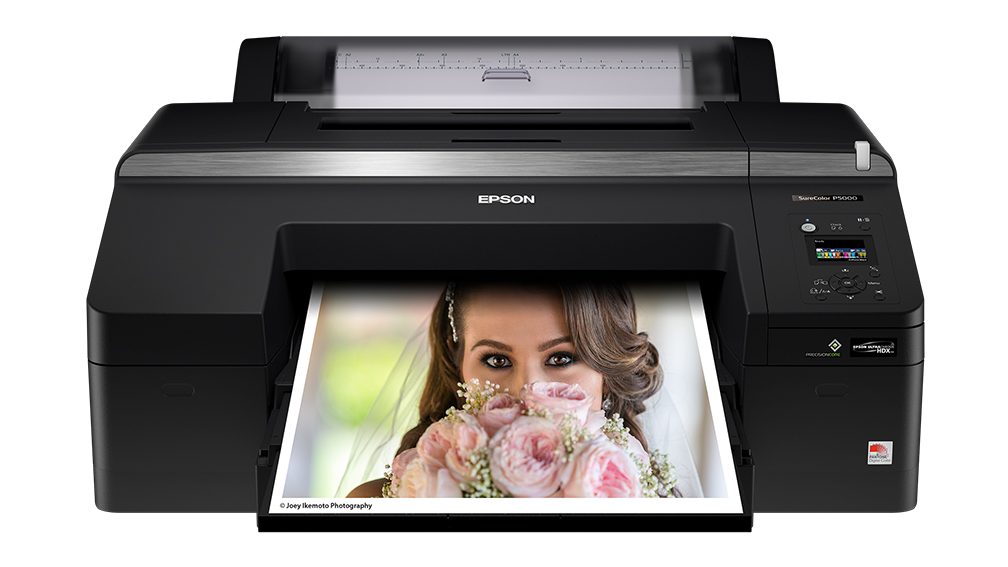Raising the Bar
Review by Steve Baczewski
The new Epson A2, SureColor P5000 printer replaces the venerable Epson 4900 with a new print head design, a new ink formulation, and overall ease of use. From the outside, the two printers look identical; however, the P5000 is large (34×30.2×15.9″) and heavy (115 lbs.), and this might be a consideration for those with limited space. The P5000 is aimed at demanding photographers who require reliable, high-quality prints, but are content with print sizes limited to 8×10″ through 17×22″. I reviewed the P5000 Standard Edition, which includes Epson’s Advanced B&W printing mode and is intended for photographers.
The P5000 has four paper feeds, three sheet feeds, and a built-in roll paper feed with cutter. The roll feed, which is power-driven, is ideal for panoramic prints. The front sheet feed is for thick stock up to 1.5mm. The paper cassette has the benefit of stacking multiple sheets of paper from 8×10″ up to 17×22″ and the added convenience of automatically switching between it and the roll feeder. The rear sheet feed is actually on top of the printer and has one annoying glitch: Its back paper support is flimsy and only telescopes out a few inches, allowing 17×22″ paper to flop backwards. Despite that, I didn’t have any paper-skewing issues; however, I found that it was important to follow Epson’s explicit directions to avoid problems.
The SureColor P5000 seems to have fixed the issue of persistent clogged nozzles that plagued the 4900 by using an ink repellent coating on its print head; by using seals to prevent dust from entering; and instituting automatic inkless nozzle checks. In more than a month, I haven’t experienced a single clogged nozzle.
Setup is straightforward, and connectivity is Ethernet or surprisingly USB 2 instead of the faster USB 3. The P5000 isn’t Wi-Fi enabled. Epson supplies excellent ICC paper profiles on installation.
The printer comes packaged with eleven 80-ml cartridges, and each standard cartridge holds 200 mls. The new UltraChrome HDK ink formulation includes black ink that’s 1.5 times denser than earlier formulations, and the difference is clear on PK paper and especially MK papers, which usually suffer from muddy blacks. The deeper, richer black provides increased contrast and helps to set off the other colors. The increased color gamut is due in part to the addition of orange and green inks, and in fact, green foliage has an extraordinary vibrancy that I haven’t seen before. One caveat is that occasionally I spotted some gloss differential on Luster paper.
The new ink formulation boasts a print permanence of 200 years for color and 400 years for B&W. I used Bill Atkinson’s test target to compare the P5000 with the 4900. Atkinson’s target is filled with relevant imagery in both color and B&W. Both printers use the same color inks but the SureColor P5000’s new formulation with the denser black wins out. The improvements can be seen in smoother tonal gradation, impressive shadow and highlight detail, and more accurate saturated colors, especially greens, reds, and yellows. Skin tones are beautiful. In general, there’s a better match between my calibrated display and prints. Printing with Epson’s Advanced B&W mode shows neutral tones, distinct tonal separation, smoother gradations, more detail, and richer blacks.
To conserve ink when switching from PK to MK, or visa versa, there’s now a quick mode that uses less ink. The P5000 has a maximum resolution of 2880×1440 dpi, a variable ink droplet size as small as 3.5 picoliters, and uses 360 nozzles per channel.
The SureColor P5000 Standard Edition is another solid printer from Epson. If you’re a professional photographer, it’s reassuring to know that the P5000 will deliver prints that match your hard work in the field. ■







Epson P5000 is one of the best printers from Epson and they are easy to use and operate. Epson manufactures one of the best printers on the market.
Epson printer built-inter is nicely designed. It’s ready with Gigabit Ethernet and USB 2.0 ports, a rotary cutter and a full color, 2.7-built-inch liquid crystal display manipulate panel. And it is easy to use and very understandable.
Epson are good printer which is designed nicely.thanks for sharing your article .
http://www.facebooknumbersupport.com/
Thanks for the sharing Epson colour printer tips. Check also here Epson 2630 printer install setup. https://www.number-customerservice.com/epson_wf-2630-install-setup/
All Epson printer set up follow this link https://www.number-customerservice.com/epson-printer-support/
Looking for reliable Canon support? Dial the Canon printer customer support toll-free phone number and get 24/7 service for resolving Canon printer related issues.
Epson printers are considered among the top-quality printers which are designed with the best quality components. Thus, they can work in every atmosphere in a proficient way. We can’t also deny the fact that a number of issues are always waiting at the edge to uncover their ways towards Epson printers. Sometimes, even your computer system is not able to detect printer and displays printer is unavailable or offline error. At that situation, instead of bewildering you need to collect your senses and get hold of Epson Support. By taking this optimum support, you will certainly be able to conquer printer offline error without difficulty.
https://www.epsonprintersupport.co/